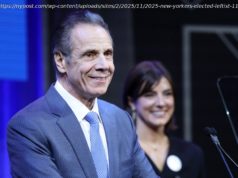Emails reviewed by The Times show that the tour company whose helicopter crashed into the East River was aware of concerns over their equipment.
For months before an open-sided helicopter capsized in the East River, drowning five passengers who had been strapped inside, pilots for the company that operated the flight warned their bosses about dangerous conditions, including equipment that could make escape difficult.
The pilots repeatedly requested more suitable safety gear, with one pilot writing in an email to company management that “we are setting ourselves up for failure” by using sometimes poorly fitting harnesses. That same pilot made a series of recommendations — including one four days before the fatal accident — for new tools that would allow passengers to more easily free themselves in case of an emergency, according to company emails, other internal documents and interviews.
The internal documents reviewed by The New York Times indicate that executives for the company, FlyNYON, bristled at the pilots’ concerns, insisting that the operation, which offered the chance to snap selfies while leaning out over the city, was safe.
“Let me be clear, this isn’t a safety issue with the harnesses,” Patrick K. Day, the chief executive of FlyNYON, said in a January email exchange with pilots who had raised concerns.
Mr. Day, in a statement to The Times, rejected the idea “that anyone at FlyNYON did not heed issues raised by pilots at Liberty Helicopter” — an affiliated company that owned and operated the helicopters used in FlyNYON flights — “and that we failed to respond to safety concerns.”
Less than two months after the email exchange, on March 11, a FlyNYON flight splashed in the East River after losing power and quickly rolled over, trapping its pilot and five passengers upside down in the frigid water.
The passengers were outfitted with some of the equipment that the pilots had raised concerns about — yellow harnesses connected to tethers that strapped them into the copter, and small cutters to slice through the tethers so they could free themselves in an emergency. The pilot, Richard Vance, was the only one who was not wearing such a harness; he used a standard seatbelt and was the sole survivor.
Mr. Vance told federal investigators that he tried to free the passenger beside him, but the helicopter was submerged before he could finish unhooking the man’s harness, according to a preliminary report .
The internal documents, and interviews with people familiar with FlyNYON’s operation and Mr. Vance’s account, paint a portrait of a company that at times appeared to put business concerns ahead of safety concerns as it scrambled to meet surging demand for a daring form of aerial tourism that it pioneered.
While government regulations and professional standards had not kept pace, the company claimed on its website that it had developed a proprietary safety system that was the class of the industry. In fact, the documents and interviews show that FlyNYON had been using mostly off-the-shelf construction harnesses that it had planned to upgrade — and that sometimes were supplemented by zip ties and blue painters tape — and tethers that could not be easily severed by the cutters provided.
The National Transportation Safety Board is investigating the crash. The Federal Aviation Administration, which had not previously specifically regulated doors-off helicopter flights, has banned any flights that use restraints that passengers cannot quickly get out of, a prohibition aimed squarely at FlyNYON.
Multiple pilots who have worked with FlyNYON and Liberty Helicopters — including the pilot who warned of the harnesses in the email — are seeking whistle-blower protections in order to speak out. They have retained a Washington lawyer who specializes in whistle-blower matters, Debra Katz. She has asked the New York attorney general’s office to investigate FlyNYON, and she sent a letter to the F. A. A., claiming that the pilots were subject to retaliation.
As a result, she wrote, “there is a pervasive feeling among Liberty pilots that if they provide truthful information to the F. A. and the N. T. S. B. and speak out about the lax safety culture and practices at FlyNYON, they will face blackballing in the industry and other forms of career-derailing retaliation.”
The New York attorney general’s office has begun a consumer-protection investigation into FlyNYON’s business practices and demanded that the company cease promoting doors-off flights, according to a person who had been briefed on the investigation.
Mr. Day, in his statement to the Times, pointed out that the F. A. had performed a site inspection of FlyNYON’s facility on Oct. 31, at which “inspectors observed the harness and tethering process and continued to permit their use on Liberty and FlyNYON operated flights without issue.”
An F. A. spokesman would not comment on the particulars of any given inspection. But the spokesman said that, since the agency’s regulations do not specifically cover supplemental restraint systems, its inspectors would not have rendered judgment on the harness system. Liberty Helicopters declined to comment.
Like some air-tour companies in other tourist destinations, FlyNYON offered flights on helicopters with the doors open or removed to allow passengers to take unobstructed photographs of the landscape below. But FlyNYON went a step further by putting passengers in harnesses attached to tethers that would let them lean out of — or dangle their legs over — the edge of the cabin.
It was an experience that previously had been available mostly to professional photographers, who booked private flights where they were often the only passengers and, therefore, could be more closely monitored by the pilots. Mr. Day and his partners recognized the potential profit in offering such an experience more widely in an era when social media users are willing to pay handsomely for activities that produce thumb-scroll-stopping photos.
“Anyone can come up and be an aerial photographer with us,” says one of FlyNYON’s promotional videos .
The company encouraged its customers to post shots of their feet suspended over landmarks like the Statue of Liberty or the Empire State Building — images the company called “shoe selfies” — on Instagram and other social media platforms. And remember, its workers requested, to please tag the company in those posts, helping to spread the word about FlyNYON’s service.
The social-media strategy was working, drawing more and more people to an industrial section of Kearny, N. J., on the edge of the Port of Newark, from which FlyNYON helicopters depart for flights over Manhattan. New York City officials had prohibited sightseeing tours from flying over land, or flying at all on Sundays. But FlyNYON got around the restrictions by departing from New Jersey and designating its flights as aerial photography missions rather than tours with defined itineraries.
Mr. Day boasted in an internal email in February that FlyNYON had defied its doubters, whom he called “dinosaurs,” and had increased last year its business by 400 percent. The company was charging as much as $500 a seat for five-passenger flights lasting 30 to 40 minutes over New York, Miami, Las Vegas, Los Angeles and San Francisco. By December, it was booking as many as 28 flights a day, according to the emails.
Some experienced pilots, like Bill Richards, saw what FlyNYON was doing and considered it reckless. Mr. Richardson, who flies camera crews in helicopters around New York to film scenes for movies and TV shows, said, “It looked crazy to all of us who do this for a living.”
He said at one point he provided a store-bought harness for professional photographers to wear while leaning out of his helicopter. But he abandoned that practice long ago, he said, and has since kept his passengers in their seats or on a camera mount approved by the F. A. A.
“Anybody who’s in a helicopter has to have an approved seat” — unless they are about to make a parachute jump, Mr. Richards said, citing a specific F. A. regulation .
On a Sunday afternoon in mid-February, six loads of FlyNYON customers were aboard helicopters trying to get pictures of the city at sundown, according to emails between company officials. The crowd of thrill seekers was overwhelming FlyNYON’s resources, the emails show. At times, the company did not have enough harnesses, tethers, carabiners or headsets to outfit one group of passengers while another was in the air, delaying liftoff, one FlyNYON official complained in a February email with the subject line, “more gear needed.”
The company ’s website says “safety has always been our top priority,” and boasts of comprehensive and rigorous passenger safety protocols. But the emails and interviews painted a different picture than what the company projected.
Among its claims was the promise of a “proprietary eight-point safety harness system.” A pilot who has worked with FlyNYON said that the company’s most commonly used harness was actually not proprietary at all, nor was it intended for aviation use.






